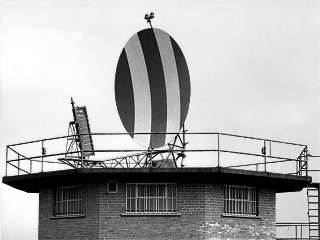ACR 6
Description of the radar set, tactical-technical characteristics

Figure 1: ACR Mark 6
(Source: atchistory.wordpress.com]
| Specifications | |
|---|---|
| frequency: | S-Band
(λ = 10 cm) |
| pulse repetition time (PRT): | |
| pulse repetition frequency (PRF): | |
| pulsewidth (τ): | |
| receive time: | |
| dead time: | |
| peak power: | |
| average power: | |
| instrumented range: | |
| range resolution: | |
| accuracy: | |
| beamwidth: | |
| hits per scan: | |
| antenna rotation: | |
| MTBCF: | |
| MTTR: | |
ACR 6
The ACR 6 (in older literature named as ACR Mark 6, ACR means Airfield Control Radar) was an operating in S-Band Airport Surveillance Radar providing medium-range surveillance in addition to approach and landing facilities.
ACR 6 used a circular parabolic antenna which was fed by a series of horn radiators. Due to this shape, the vertical beamwidth was also very narrow, so that the entire antenna was tilted slightly upwards to meet the requirements for the glide path. The ACR 6 incorporated several features which were considered novel at that time:
- The radar was fitted with a moving target indicator to cancel out ground returns.
- The radar used circular polarization to reduce the effects of weather clutter.
- The display incorporated a system whereby local map features could be overlaid on the radar picture electronically.
- There was a built-in test system with comprehensive monitoring and metering.
The first ACR 6 becomes operational at London Heathrow in August 1955. Other main British airports have been equipped, for example Gatwick and Stansted. Also, some ACR systems were exported: two were in Switzerland, where they were installed in Geneva and Zurich, and two more went to Netherland, being installed in Soesterberg and Gilze Rijen.
The precision with which Cossor built the antennas was such that even when radars were replaced by more modern ones, the original Cossor antennas were maintained.
